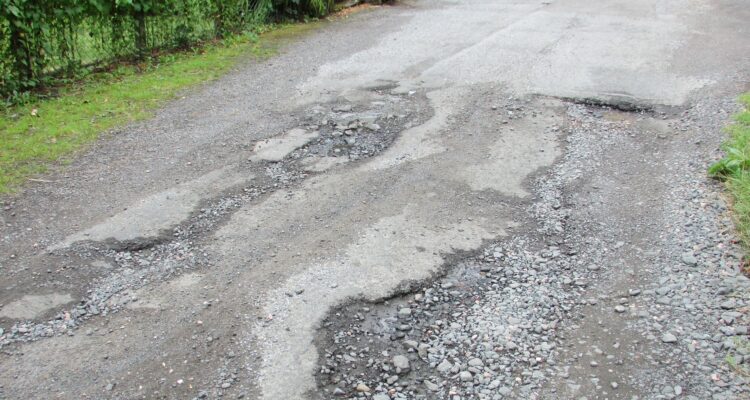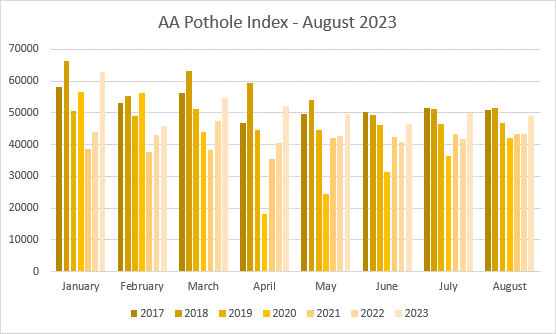Motorists have been warned that the risk to life because of potholes is now severe, as new figures reveal UK roads are in the worst condition in years.
The team at Road Angel is urging councils to fork out and repair potholes or they say road users ‘will lose their lives’.
Local authorities paid out over £32 million in compensation for 5,596 personal injury claims due to potholes between 2017 and 2021, according to a freedom of information request.
Meanwhile, figures from the AA show pothole-related breakdowns hit a five-year high in July this year, with 50,079 callouts to vehicles stranded with faults caused by potholes, an increase of nearly one-fifth from 41,790 in July 2022.
Road Angel says a wet summer has meant that UK roads are in a worse condition than expected as water causes greater damage and repairs are harder to carry out.
If left, the organisation notes potholes grow in size as traffic wears away the edges leaving greater numbers of larger holes that will cause serious damage if driven through.
Gary Digva, founder of Road Angel, is now pleading with local authorities to assess the risk to life if the pothole problem in the UK is not repaired.
He said: “It is shocking to see that the pothole plague in the UK is not being taken seriously by local councils given how many people are injured because of them.
“With fewer potholes being repaired than in the last decade, it is only a matter of time before we start seeing an increase in accidents, injuries and fatalities unless something changes.
“Potholes are incredibly dangerous for motorists as they can cause them to lose control, especially if they cause damage to the tyres of suspension, or swerve out of the way to prevent damage.
“Almost 30,000 people were killed or seriously injured on UK roads last year, and we fear these numbers could increase with the current state of the roads.
“Potholes not only pose a threat to motorists, but they are also dangerous for cyclists because the uneven surfaces can cause the bike to lose control, leading to accidents and serious injuries.
“Pedestrians could also get caught in the crossfire of out-of-control vehicles, putting them at serious risk of harm if walking along a busy road.
“To make matters worse, we have had an unusually wet summer this year which makes potholes harder for road users to see, meaning more people are at risk of hitting potholes and losing control.
“The best advice to motorists while the roads are in this substandard condition is to drive with caution at all times and reduce speeds when approaching a pothole.”
While many local roads are still covered in holes, the councils responsible for them now find themselves in a race against time to repair as many as possible before the autumnal weather reaches Britain. Roads authorities lost numerous repair days this summer due to the wetter conditions, and are now keeping their fingers crossed for a dry spell to make up for lost time. The warm start to September could be the calm before the storm as roads deteriorate once the colder and wetter weather hits.
Jack Cousens, head of roads policy for the AA, said; “During what felt like a continuous spell of rain throughout August, drivers faced the now familiar challenge of trying to spot potholes lurking beneath the surface of rainwater. Some driver’s attempts to avoid damage to tyres, suspensions and steering mechanisms appear to have been in vain as we witnessed another year-on-year increase in pothole-related incidents.
“Councils now have a very small window of time to get as much of their repair work carried out as possible before the real autumn and winter weather hits, meaning their road teams will need to work flat out to restore the roads before the weather really turns against them.
“2023 looks set to reach the podium of ‘Worst Year for Potholes’, but which colour medal remains to be seen. With this year’s running total of pothole-related breakdowns already at 411,168 compared to previous annual totals of 594,876 (2019) and 637,932 (2017), the current toll looks comfortable for a bronze at least. An awful autumn could see it make a dash for gold. That’s why, with the Autumn Statement due in November**, drivers and local councils alike will be hoping for some more pothole funding.”
Finally, in a new report, the All-Party Parliamentary Group (APPG) for Better Roads says one of its aims is to “promote the case for properly maintained local roads”.
The report reviews the Pothole Action Fund, suggesting the policy contributed to ‘marked improvements’ in the conditions of local roads when it was in place from 2015-2021.
The fund, a six-year commitment allocated to English local authorities, could be used by highway teams to secure funding for preventative maintenance and resurfacing works as well as pothole repairs.
Analysis referenced in the report, drawn from the Alliance’s Annual Local Authority Road Maintenance (ALARM) survey, indicates that the ring-fencing led to an increased proportion of England’s local network being classed as in ‘good condition’, with 12,377 miles – 7% – of local roads moving into this category over the six years the fund was available.
Since 2021, when the pothole action fund was incorporated into councils’ general block highway funding from the DfT, the proportion of roads classed as ‘good’ has fallen by 5%, or 8,811 miles of roads.
The APPG’s report also highlights that the average shortfall in authorities’ highway maintenance budgets has increased by 82% since the end of ring-fenced funding.
Sir Christopher Chope MP, chairman of the APPG for Better Roads, said: “One of the aims of this APPG is to promote the case for properly maintained local roads to provide a more resilient and carbon efficient network.
“This is why we are sharing the findings of the review into the Pothole Action Fund to underpin our call for a return to targeted, sustained and ringfenced local road maintenance funding.”







